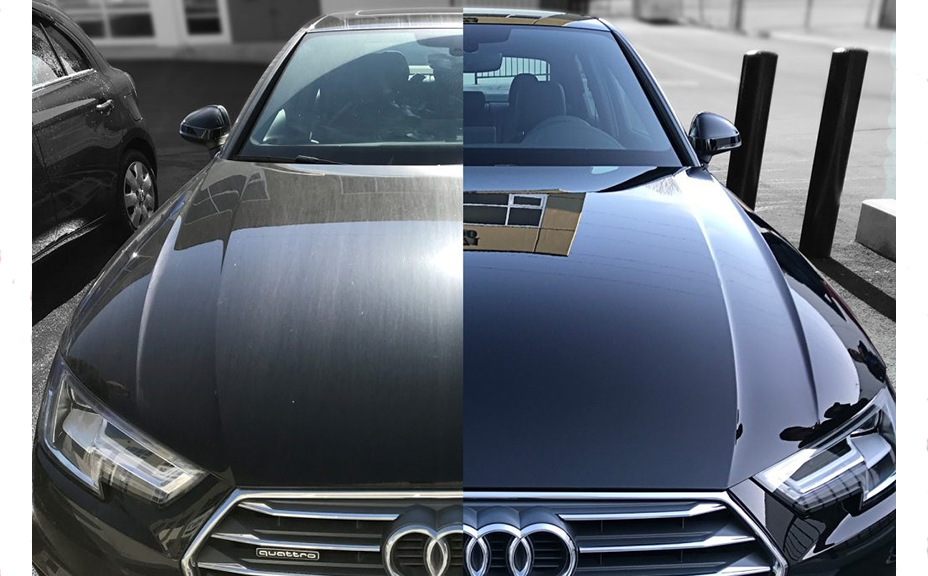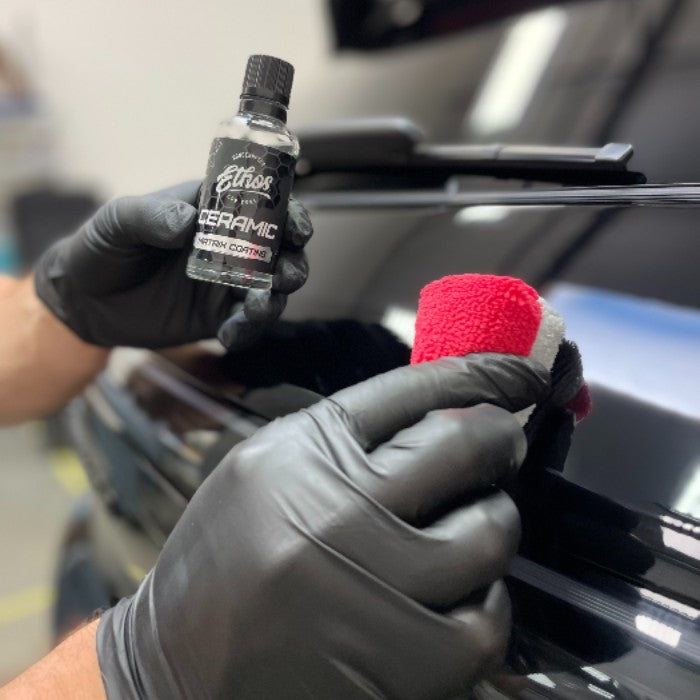How Ceramic Coating Newark saves you money over time
Discovering the Scientific Research Behind Car Ceramic Coating and Its Safety Qualities
The scientific research of car ceramic coating presents a fascinating research in advanced vehicle security. Composed mainly of silicon dioxide and polymers, these coverings form a robust bond with lorry paint. This interaction enhances durability against ecological dangers while using hydrophobic benefits. Nonetheless, the complexities of how these finishings work and their long-lasting advantages stay less understood. Unloading these details reveals why ceramic finishings are becoming a preferred option for vehicle treatment
What Is Ceramic Coating?
Ceramic coating is a liquid polymer that chemically bonds to the surface area of a car's paint. This innovative safety layer improves resilience and provides premium resistance to ecological aspects. Unlike typical wax or sealers, which supply short-term security, ceramic coatings develop a lasting guard that can withstand extreme problems such as UV rays, acidic impurities, and extreme weather. When used correctly, the coating forms a hydrophobic surface area, causing water to bead and slide off, which helps in maintaining the vehicle's tidiness. In addition, it supplies improved gloss and depth to the paint, making the vehicle show up more polished and vivid. The application process normally entails detailed surface prep work, including cleaning and polishing, to assure peak bonding. Because of this, ceramic finishes are becoming significantly prominent among car fanatics and those looking for to shield their investments, promising to maintain the car's aesthetic charm while reducing the frequency of upkeep.
The Structure of Ceramic Coatings
The elaborate formulation of ceramic layers largely includes silicon dioxide (SiO2), which is acquired from natural resources like quartz and sand. This essential component provides the structure for the coating's sturdiness and safety top qualities. Along with SiO2, ceramic finishes typically consist of various polymers and ingredients that enhance attachment, versatility, and resistance to environmental elements. These substances function synergistically to develop a durable barrier against pollutants such as dust, chemicals, and UV rays.Furthermore, some solutions include titanium dioxide (TiO2) or other nanomaterials, which can enhance the coating's hydrophobic properties, leading to better water repellency. The precise composition can vary substantially amongst makers, affecting performance and durability. Eventually, the combination of these aspects culminates in a safety layer that not only enhances the visual allure of automobiles however also offers to extend their life-span by protecting the surface area from prospective damage.
Exactly How Ceramic Coatings Work
Comprehending exactly how ceramic finishings function includes exploring their chemical make-up, which contributes to their safety qualities. The application procedure is important for attaining optimal results, while durability and durability aspects establish the coating's efficiency gradually. With each other, these aspects highlight the advantages and performance of ceramic finishings for lorry protection.
Chemical Make-up Explained
While several car owners look for durable defense for their automobiles, the chemical composition of ceramic coatings plays a vital role in their performance. These finishings primarily include silicon dioxide (SiO2), which is originated from natural minerals. This compound develops a solid bond with the vehicle's paint, producing a resilient, protective layer. Additionally, several ceramic finishes include titanium dioxide (TiO2), improving their hydrophobic properties and resistance to UV rays. The visibility of polysiloxanes can additionally enhance versatility and durability. Together, these components add to the coating's capacity to repel water, dust, and impurities, while additionally providing a high-gloss coating. Comprehending this chemical foundation helps car owners appreciate the robust protection provided by ceramic coverings.
Application Process Overview
Using ceramic coatings involves a careful process that ensures perfect bonding and protection for the car's surface. Complete cleaning and purification of the car's exterior are executed to eliminate dirt, grime, and previous waxes. This action verifies that the surface is totally free from contaminations that might hinder attachment. Following this, the paint is usually polished to improve quality and get rid of any kind of blemishes. Once prepared, the ceramic coating is applied in tiny sections utilizing an applicator pad, permitting uniform coverage. The coating is then delegated heal, creating a solid chemical bond with the surface area. Appropriate curing times and conditions are crucial, as they validate the coating achieves its optimum efficiency and protective high qualities.
Longevity and Longevity Factors
Ceramic coverings are created to offer durable security via their innovative chemical composition, which develops a durable barrier against ecological impurities. The toughness of these layers is influenced by variables such as the thickness of the application, the top quality of the item, and the conditions under which the automobile is find exposed. High-quality ceramic coatings can last several years, standing up to scrapes, UV rays, and chemical discolorations. Appropriate upkeep, consisting of routine washing and regular reapplication, can even more boost longevity. Furthermore, ecological variables like climate and exposure to pollutants can impact the life-span of the coating. In general, when applied and maintained properly, ceramic coverings provide phenomenal durability, making them a preferred choice for car enthusiasts seeking to preserve their car's look.
Hydrophobic Properties and Water Repellency
Hydrophobic residential properties are a trademark of top quality car ceramic finishings, substantially improving the automobile's surface performance. These finishings create a molecular bond with the car's paint, resulting in a surface that pushes back water efficiently. When water enters contact with a ceramic-coated surface, it grains up and rolls off, lessening the amount of fluid that stays on the paint. This behavior not just adds to a cosmetically pleasing look yet also reduces the buildup of pollutants such as dirt, crud, and roadway salts.The enhanced water repellency results in easier cleansing and maintenance, as much less initiative is required to eliminate unwanted materials. Furthermore, the hydrophobic nature of ceramic finishes helps in protecting against water places, which can mar the finish of uncoated surface areas. Generally, the unification of hydrophobic residential or commercial properties in ceramic layers plays a vital role in keeping the lorry's beautiful look while simplifying maintenance.
Defense Versus Scratches and UV Damages
Car ceramic coatings supply substantial security versus scratches and UV damage. The scratch resistance device produces a durable layer that soaks up influences, while the UV protecting advantages help keep the lorry's paint integrity over time. With each other, these attributes add to a longer-lasting and aesthetically appealing surface.
Scrape Resistance Device
Making use of innovative innovation, ceramic finishings offer a robust guard versus scratches and UV damages, enhancing the durability and appearance of vehicle surface areas. The scratch resistance mechanism of these finishes is connected to their special molecular structure, which forms a durable bond with the automobile's paint. This bond produces a hard, protective layer that can absorb effects and resist abrasions. In addition, the smooth surface area of the coating minimizes friction, making it difficult for contaminants to adhere and trigger scratches. The chemical structure of ceramic finishes frequently includes nanoparticles that enhance the protective layer, more enhancing its resilience. Subsequently, cars treated with ceramic coatings display substantially improved scratch resistance compared to traditional wax or sealers, ensuring a pristine surface in time.
UV Shielding Conveniences
The safety qualities of ceramic finishes expand beyond scratch resistance to consist of significant UV shielding advantages. These finishes create a durable obstacle that mirrors hazardous ultraviolet rays, protecting the vehicle's paint and underlying products. Prolonged direct exposure to UV radiation can lead to fading, oxidation, and degeneration of the paint coating. By incorporating ceramic coverings, lorry proprietors can effectively minimize these risks, protecting the visual appeal and honesty of i thought about this their cars. Additionally, the UV obstructing properties contribute to improved durability, reducing the regularity of painting and maintenance. Ultimately, the integration of ceramic finishes offers a comprehensive option for shielding automobiles from the damaging effects of sunlight direct exposure, guaranteeing a continual, vibrant look with time.
The Long life and Upkeep of Ceramic Coatings

Regularly Asked Questions
Can Porcelain Coating Be Applied to Any Kind Of Kind of Automobile?
Ceramic coating can be put on numerous kinds of automobiles, including vehicles, trucks, and motorbikes. Nonetheless, surface prep work and compatibility with certain products are vital for suitable attachment and efficiency of the coating.
How Much Does Ceramic Coating Commonly Price?
Ceramic coating typically costs in between $500 and $2,000, depending on aspects such as vehicle size, coating top quality, and specialist application. The financial investment can give durable security and enhance the car's appearance gradually.

Is Expert Application Required for Finest Results?
The need of expert application typically depends upon wanted outcomes. Experts commonly assure correct surface prep work and application strategies, leading to perfect bonding and long life of the coating, which might be challenging for inexperienced people to attain.
Can Ceramic Coatings Be Gotten Rid Of or Fixed?
Ceramic finishes can be gotten rid of or repaired, though the procedure may require specific solvents or strategies - Ceramic Coating Newark. Proper removal is necessary to prevent damage to the underlying surface, stressing the value of specialist support for suitable results
Just How Does Porcelain Coating Contrast to Conventional Wax?
The contrast between ceramic coating and typical wax discloses that ceramic finishes offer superior longevity, boosted security versus environmental pollutants, and longer-lasting shine, while wax needs more constant application and offers much less total resistance to damages.